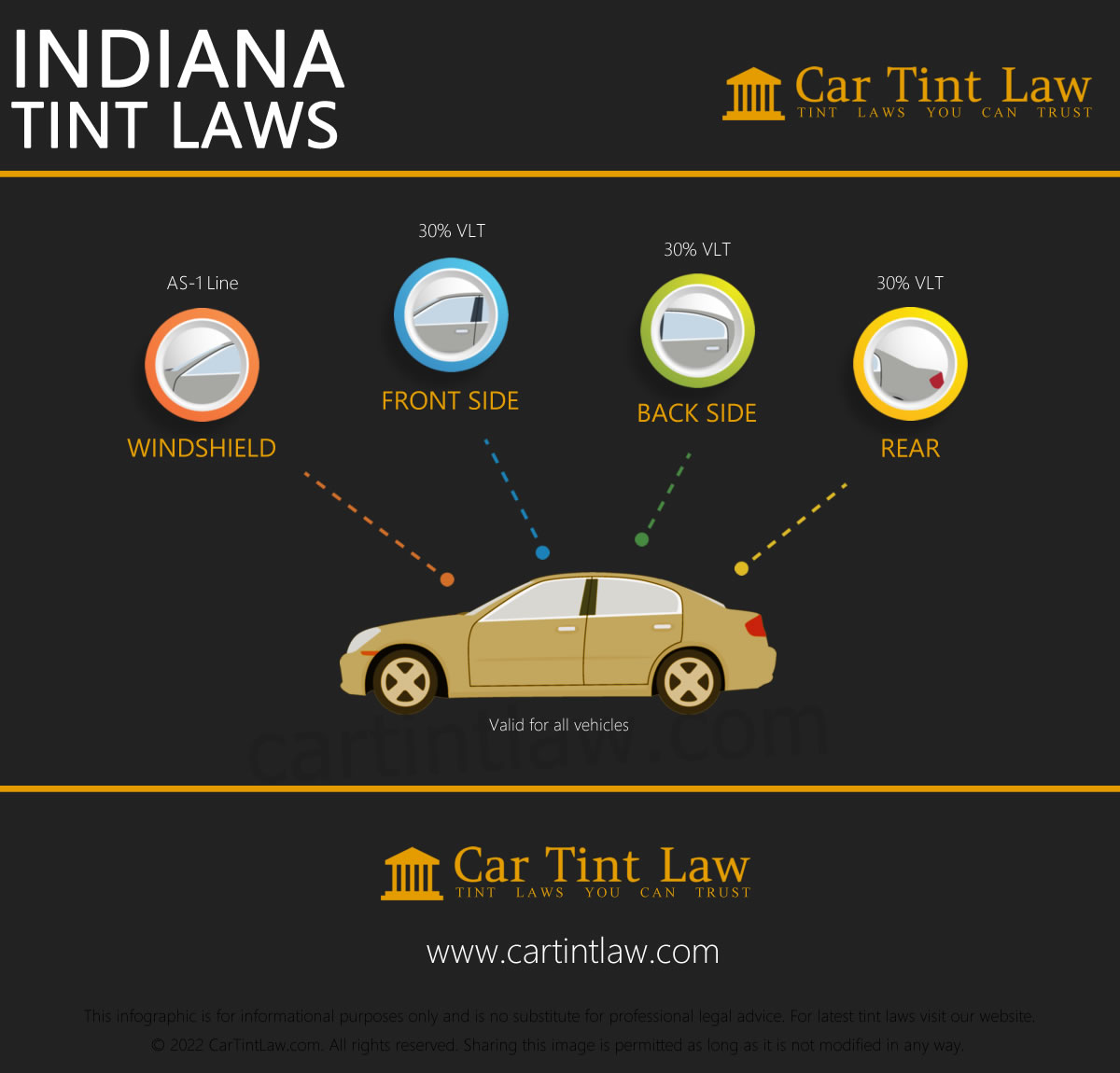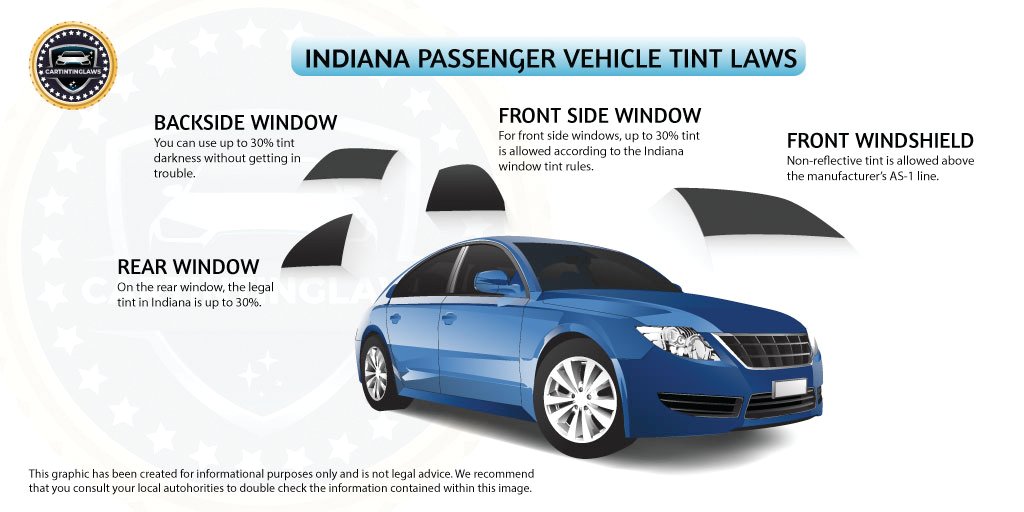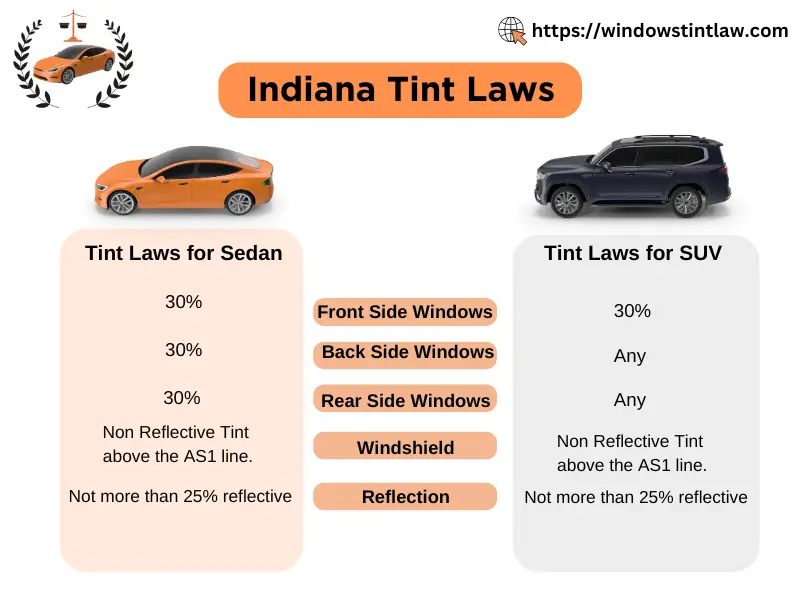Are you planning to tint your car windows in Indiana? Before you dive into this popular upgrade, it’s crucial to understand the Indiana Tint Law.
Not only does it keep you on the right side of the law, but it also ensures your safety and comfort on the road. Imagine cruising through your favorite routes, knowing your tint perfectly balances style and legality. You’ll discover everything you need to know about the regulations, so you can make informed choices and avoid potential fines.
Keep reading to unlock the secrets behind choosing the perfect tint for your vehicle.
Tint Law Basics
Indiana’s tint laws play a vital role in vehicle safety and regulation. Understanding these laws helps drivers avoid penalties and maintain compliance. This section breaks down the basics of tint regulations and the types of window tints allowed.
Purpose Of Tint Regulations
Tint regulations exist to ensure road safety. They prevent excessive darkening of windows which can obstruct visibility. Law enforcement needs clear visibility into vehicles for safety checks. Tint laws also ensure uniformity in vehicle appearance. These rules protect pedestrians and other drivers from glare.
Types Of Window Tints
Window tints come in various types, each serving different purposes. Dyed tints absorb sunlight and reduce glare. Metalized tints reflect sunlight, offering better heat reduction. Carbon tints provide UV protection without interfering with electronics. Ceramic tints offer high performance and durability. Understanding these types helps in choosing the right tint for your vehicle.
Indiana Legal Tint Limits
Indiana Tint Law outlines specific regulations for window tinting on vehicles. Front side windows must allow over 30% light passage, while back windows can be darker. Adhering to these rules ensures legal compliance and avoids penalties.
Understanding the legal tint limits in Indiana is crucial for anyone who drives in the state. Tint laws can vary widely from one state to another, and Indiana is no exception. Knowing these rules not only helps you avoid fines but also ensures your vehicle remains safe and comfortable to drive.Tint Darkness Restrictions
In Indiana, the darkness of your window tint is measured by Visible Light Transmission (VLT) percentage. This percentage refers to the amount of light that can pass through your car windows. For sedans, the front side windows must allow more than 30% of light in. Rear side windows and back windows can have any darkness level. SUVs and vans have slightly different rules. The front side windows also need to allow more than 30% light in, but like sedans, the rear side windows and back windows can be as dark as you prefer. Imagine driving on a sunny day with just the right tint—it’s not only about comfort but also about protecting your car’s interior from sun damage.Reflectivity Rules
Reflectivity in window tinting refers to the amount of light the tint reflects. Indiana law specifies that the tint must not be more reflective than a standard window. This means your tint should not have a mirror-like appearance. Reflective tints can cause glare for other drivers, creating a safety hazard on the road. Ensuring your tint stays within the legal reflectivity limits is not only about compliance; it’s about being considerate of those you share the road with. Have you ever driven behind a car with glaring windows? It can be blinding and dangerous. Knowing and following these tint laws is essential. They don’t just prevent potential fines; they also enhance your driving experience. So, before you decide on that new tint shade, make sure it aligns with Indiana’s legal requirements. Are you willing to risk a ticket just for a little extra shade?Exceptions To The Rules
Indiana’s tint law sets strict guidelines for window tint darkness. Exceptions exist for medical needs, allowing higher tint levels. These exceptions require documentation to ensure compliance.
Navigating the laws around window tinting in Indiana can sometimes feel like a puzzle. But did you know there are exceptions to these rules? Whether it’s for medical reasons or specific vehicle types, understanding these exceptions can make your life a bit easier. Let’s dive into how these exemptions might apply to you and your vehicle.Medical Exemptions
In Indiana, if you have a medical condition that necessitates darker window tints, you’re in luck. The state allows exemptions for medical reasons, such as skin conditions that require reduced sun exposure. To qualify, you’ll need a doctor’s note. This document should explain your condition and the necessity for the exemption. It’s not just a free pass, though. You still need to carry this documentation in your vehicle at all times. Have you ever experienced discomfort while driving due to sun exposure? This exemption could be your solution. It’s a practical way to ensure your health and comfort without breaking the law.Special Vehicle Categories
Not all vehicles are created equal, and Indiana’s tint laws recognize that. Vehicles like hearses, limousines, and ambulances have their own set of rules. These vehicles often have specific operational needs that justify darker tints. Imagine you’re driving a limousine. Your clients expect privacy and comfort, which darker tints provide. The law acknowledges this, allowing for special considerations. If you own or drive a vehicle in this category, it’s crucial to know these exceptions. Always check the specific requirements that apply to your vehicle type. This knowledge not only keeps you compliant but also ensures you’re providing the best service or care in your special vehicle. Understanding these exceptions can save you time and trouble. Have you ever been caught off guard by a regulation you didn’t know existed? Being informed about these specific exemptions can prevent that headache. Stay knowledgeable and drive with confidence, knowing that Indiana law considers your unique needs.
Credit: www.cartintlaw.com
Penalties And Fines
Violating Indiana’s tint law can lead to penalties and fines. Drivers may face fines if their window tint is too dark. It’s important to know the legal tint levels to avoid these costs.
Understanding the penalties and fines associated with Indiana’s tint law is crucial for drivers who want to avoid unnecessary expenses. If you’re planning to tint your car windows, knowing what violations can lead to fines is essential. This section dives into the common violations and the fine structure, helping you navigate the legal aspects of window tinting in Indiana.Common Violations
One common mistake people make is applying tint that exceeds the permissible level. Indiana law specifies that the front side windows must allow over 30% of light in. Another frequent violation is having reflective tint on the front side windows. Reflective materials can distract other drivers and are not permitted. Ignoring the rules for the rear window is also a typical misstep. While you can go darker, proper visibility is still required. Have you ever wondered if your vehicle’s tint level is within legal limits? Checking this before hitting the road can save you from fines.Fine Structure
Indiana has a structured approach to fines for tint violations. If your tint is too dark, you might face penalties starting at $50. Repeat offenses can lead to increased fines. The more violations you accumulate, the higher the penalties become. Getting pulled over with reflective tint can result in an immediate fine. Law enforcement takes these violations seriously due to safety concerns. Understanding the specific fine amounts can be challenging. But keeping your tint legal will ensure you avoid unexpected expenses. Is it worth risking a fine for a darker tint? Consider the potential costs before deciding on your vehicle’s appearance. Being aware of these penalties can make all the difference. Stay informed and ensure your tint complies with Indiana law.Legal Tint Installation
Legal tint installation in Indiana ensures your vehicle complies with state laws. Installing window tint involves specific regulations you must follow. Knowing these laws helps avoid fines and ensures your car remains street-legal. Choosing the right installer plays a crucial role in compliance.
Choosing A Certified Installer
Selecting a certified installer guarantees professional service and adherence to regulations. Certified professionals understand Indiana’s tint laws thoroughly. They ensure the correct tint percentage is applied to your windows. Their expertise prevents potential legal issues and enhances your vehicle’s safety.
A certified installer uses quality materials that last longer. They provide warranties, assuring you of the tint’s durability. Research local installers and check their certifications. This step ensures your vehicle’s tinting meets the required standards.
Ensuring Compliance
Ensuring compliance with Indiana tint laws protects you from penalties. The law specifies visible light transmission percentages for each window. Front side windows need to allow more light compared to rear windows. Certified installers know these requirements well.
They measure the tint’s darkness accurately, adhering to legal limits. Regular checks on your vehicle’s tint help maintain compliance. Keep documentation from your installer to show law enforcement, if needed. This documentation serves as proof of a legal installation.
Understanding and following the law keeps your vehicle safe and legal. Stay informed about updates to Indiana’s tint laws. This knowledge helps in maintaining compliance over time.
Maintaining Your Tinted Windows
Tinted windows can be a stylish and functional addition to your vehicle, enhancing privacy and reducing glare. However, maintaining them requires careful attention to ensure they remain in top condition and comply with Indiana’s tint laws. Proper care not only preserves their appearance but also extends their lifespan. Let’s dive into some practical tips to keep your tinted windows looking pristine.
Cleaning Tips
Using the right cleaning products is crucial. Opt for ammonia-free glass cleaners to avoid damaging the tint film. Ammonia can cause the tint to peel or fade over time. Mild soap and water often do the trick without compromising the tint.
When cleaning, use a soft microfiber cloth. This prevents scratches that can mar the surface of your tinted windows. Avoid using abrasive materials or brushes that could harm the tint film.
Consider the frequency of cleaning. Regular cleaning keeps your windows clear and prevents buildup of dust and grime. But excessive cleaning can stress the tint. Try cleaning once a month for optimal results.
Regular Inspections
Keep an eye on your tinted windows. Regular inspections allow you to spot early signs of damage, such as bubbling or peeling. Addressing these issues promptly can save you money and hassle in the long run.
Check the edges of the tint film. Peeling or lifting at the edges can indicate a problem. This might mean the tint wasn’t applied correctly or needs replacing. It’s better to fix minor issues before they escalate.
Consider the impact of Indiana’s weather conditions. Extreme temperatures can affect the adhesive on your tint. A quick inspection after a hot summer or cold winter can help ensure your tint remains intact.
Are you confident your tinted windows comply with Indiana’s tint laws? Regular checks can help you avoid fines and ensure your vehicle remains roadworthy. Maintaining your tinted windows is not just about aesthetics—it’s about safety and compliance too.
Faqs On Tint Laws
Understanding Indiana’s tint laws can be challenging for many drivers. People often have questions about what is allowed and what is not. It’s important to know the rules to avoid fines or penalties. This section covers some of the most common concerns and clarifications. Dive into these FAQs for clear answers.
Common Concerns
Many drivers worry if their tint is too dark. Indiana law sets specific limits on window tinting. Front side windows must allow more than 30% of light in. Rear side windows can be darker, but must allow more than 30% of light. These limits help ensure safety and visibility on the road.
Another common concern is about medical exemptions. Some drivers need darker tint due to health reasons. Indiana allows exemptions for medical conditions. Drivers must have a doctor’s note to apply for an exemption. This note must explain the need for special tinting.
Clarifications
People often ask if tint laws apply to all vehicles. Indiana tint laws apply to all passenger vehicles. This includes cars, trucks, and SUVs. Commercial vehicles may have different regulations. It’s important to check the specifics for your vehicle type.
Another clarification is about penalties for violating tint laws. Drivers found with illegal tint may face fines. These fines vary based on the violation. Removing illegal tint is necessary to avoid repeat offenses. Ensuring compliance is crucial for every driver.

Credit: www.journalreview.com

Credit: windowstintlaw.com
Frequently Asked Questions
What Is The Darkest Legal Tint In Indiana?
In Indiana, the darkest legal window tint for passenger vehicles is 30% VLT for the front side windows. The back side and rear windows can have any darkness. Ensure your vehicle complies with these regulations for safety and legality.
Is 20% Tint Illegal In Indiana?
20% tint is illegal on front side windows in Indiana. State law requires a minimum of 30% light transmission. You can use 20% tint on rear windows and back windshield. Always check local regulations for updates and compliance.
Is 35% Or 20% Tint Darker?
20% tint is darker than 35% tint. A lower percentage means less light passes through, resulting in a darker tint.
In What State Is 20% Tint Legal?
20% tint legality varies by state. Check local laws to ensure compliance. States like Michigan and California allow 20% tint for rear windows, but front window regulations differ. Always verify specific state regulations before applying tint.
Conclusion
Indiana’s tint law helps ensure safety and visibility on roads. Understanding these rules can prevent fines and enhance driving experiences. Follow the guidelines to keep your vehicle compliant. Safe driving starts with clear views. Tint regulations protect both drivers and pedestrians.
Always check local updates for any changes. Stay informed and drive confidently in Indiana. Your awareness keeps you and others safe. Remember, proper tinting is a small step towards safer journeys. Make sure your vehicle meets the legal standards. Safety and compliance go hand in hand for a smoother drive.
